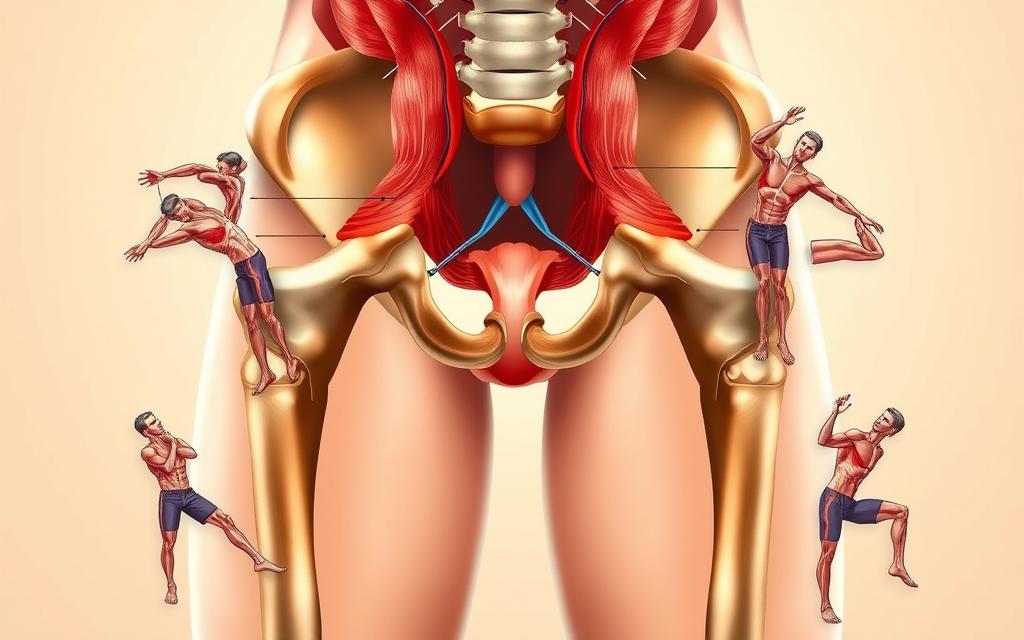Effective Exercises for Erectile Dysfunction
Erectile dysfunction (ED) can be a challenging condition to manage, but incorporating specific exercises into your daily routine can significantly improve sexual health. Research suggests that certain physical activities can enhance erectile function by improving blood flow and overall cardiovascular health.
Engaging in regular pelvic floor exercises, such as Kegels, can help strengthen the muscles that support erections. Additionally, aerobic exercise has been shown to benefit individuals with ED, with optimal results seen when exercising four times a week for at least 40 minutes per session. Maintaining a healthy lifestyle, including a balanced diet and stress management techniques, can also contribute to better erectile function.
By incorporating these exercises and lifestyle changes, individuals can take a proactive approach to managing ED and improving their overall sexual health.
Understanding Erectile Dysfunction and Its Causes
Erectile dysfunction is a complex condition influenced by a multitude of factors, including both physical and psychological elements. To effectively address ED, it’s crucial to understand its underlying causes.
Physical Factors Contributing to ED
Physical factors play a significant role in the development of erectile dysfunction. Conditions such as diabetes, hypertension, and cardiovascular disease can damage blood vessels and nerves, impairing erectile function. Additionally, obesity and lack of physical activity can contribute to the development of these conditions, further increasing the risk of ED.
| Physical Condition | Impact on Erectile Function |
|---|---|
| Diabetes | Damages nerves and blood vessels |
| Hypertension | Impairs blood flow |
| Cardiovascular Disease | Reduces blood flow to the penis |
Psychological Aspects of Erectile Dysfunction
Psychological factors, including stress, anxiety, and depression, can also significantly impact erectile function. These conditions can affect the brain’s ability to send signals to the nerves that control erection, making it difficult to achieve or maintain an erection.
The Connection Between Physical Activity and Sexual Health
Regular physical activity is known to improve overall cardiovascular health, enhance blood flow, and reduce stress and anxiety—factors that are crucial for maintaining healthy erectile function. Engaging in regular exercise can help mitigate some of the physical and psychological factors that contribute to ED.
How Exercises for Erectile Dysfunction Work
The benefits of exercise for erectile dysfunction are multifaceted, impacting both physical and psychological aspects of the condition. Regular physical activity can lead to significant improvements in erectile function by addressing various underlying causes.
Improved Blood Circulation and Vascular Health
Exercise is known to enhance blood circulation, which is crucial for achieving and maintaining an erection. Physical activity strengthens the heart and improves the health of blood vessels, allowing for better blood flow to the penis. This can be particularly beneficial for individuals with erectile dysfunction caused by vascular issues.
Hormonal Balance and Testosterone Production
Regular exercise can also influence hormonal balance, particularly testosterone levels, which play a significant role in sexual function. Certain types of exercise, such as resistance training, have been shown to boost testosterone production, potentially improving erectile function.
Stress Reduction and Mental Well-being
Exercise is a well-documented stress reducer and can improve mental well-being, both of which are important for sexual health. By reducing anxiety and depression, exercise can help alleviate psychological barriers to achieving an erection.
| Exercise Benefits | Description | Impact on ED |
|---|---|---|
| Improved Circulation | Enhanced blood flow due to strengthened heart and healthier blood vessels | Better erectile function due to increased blood flow to the penis |
| Hormonal Balance | Increased testosterone production through resistance training | Improved sexual function and libido |
| Stress Reduction | Reduced anxiety and depression through physical activity | Alleviation of psychological barriers to erection |
Pelvic Floor Exercises to Strengthen Erectile Function
The pelvic floor muscles play a vital role in erectile health, and exercising them can lead to significant improvements in erectile function. Strengthening these muscles through targeted exercises can enhance blood flow, improve muscle tone, and boost overall sexual performance.
Basic Kegel Exercise Techniques
Kegel exercises are a fundamental component of pelvic floor strengthening. To perform a Kegel exercise, identify the muscles used to stop the flow of urine, then contract and release them. Start with 5-10 repetitions and gradually increase to 20-30 as the muscles strengthen.
Tips for Effective Kegel Exercises:
- Contract the muscles for 5 seconds
- Release for 5 seconds
- Repeat for 10 minutes, 3 times a day
Advanced Pelvic Floor Workout Routines
Once comfortable with basic Kegel exercises, individuals can progress to more advanced routines. These may include:
- Quick contractions: Rapidly contract and release the pelvic floor muscles
- Long holds: Hold the contraction for 10 seconds or more
- Weighted Kegels: Use light weights or cones to increase resistance
Using Biofeedback to Enhance Results
Biofeedback devices can help individuals become more aware of their pelvic floor muscles, allowing for more effective contractions. By using biofeedback, users can:
- Improve muscle control
- Enhance exercise effectiveness
- Track progress over time
Tracking Progress and Measuring Improvement
To measure the effectiveness of pelvic floor exercises, keep a log of workouts and note any improvements in erectile function. Regular check-ins can help identify what’s working and what may need adjustment.
| Exercise Routine | Frequency | Noted Improvement |
|---|---|---|
| Basic Kegels | 3 times a day | Improved erectile firmness |
| Advanced Kegels with weights | 2 times a day | Enhanced muscle control |

By incorporating pelvic floor exercises into a regular routine and utilizing tools like biofeedback, individuals can take a proactive approach to improving erectile function and overall sexual health.
Cardiovascular Exercises That Combat Erectile Dysfunction
Cardiovascular exercises are not just beneficial for heart health; they also play a significant role in improving erectile function. By enhancing blood flow and overall vascular health, these exercises can be a crucial component in managing erectile dysfunction (ED).
Walking and Jogging Programs for ED
Walking and jogging are simple yet effective cardiovascular exercises that can help combat ED. These activities improve blood circulation, boost cardiovascular health, and can be easily incorporated into daily routines.
- Walking: Aim for at least 30 minutes of brisk walking per day. This can be broken down into shorter sessions if needed.
- Jogging: Start with short jogging intervals and gradually increase the duration as your fitness level improves.
Swimming and Water-Based Exercises
Swimming is another excellent cardiovascular exercise that is gentle on the joints and can be very effective in improving erectile function. Water-based exercises like aqua jogging or water aerobics can also be beneficial.
Benefits of Swimming:
- Improves cardiovascular health
- Enhances muscle strength and endurance
- Reduces stress and promotes relaxation
Cycling and Stationary Bike Workouts
Cycling, whether on a stationary bike or outdoors, is a popular cardiovascular exercise. It’s effective for improving heart health and can be adapted to different fitness levels.
Avoiding Potential Cycling-Related Issues
While cycling is beneficial, it’s essential to be aware of potential issues such as numbness or discomfort in the genital area. Adjusting the bike seat and handlebars to a comfortable position can help mitigate these issues.
- Ensure the saddle height is correct to avoid putting pressure on sensitive areas.
- Take regular breaks during long cycling sessions.
- Consider using a saddle designed to reduce pressure on the perineum.
Strength Training to Boost Sexual Performance
By incorporating strength training into your regimen, you can experience significant improvements in erectile function and sexual confidence. Strength training is not just about building muscle; it’s also about enhancing overall health, including sexual well-being.
Strength training can improve sexual performance in several ways: by enhancing blood flow, boosting testosterone levels, and increasing stamina. Let’s explore how different aspects of strength training can benefit erectile function.
Lower Body Exercises for Improved Blood Flow
Lower body exercises, such as squats and lunges, are particularly effective for improving blood flow to the pelvic region. Squats, for instance, work multiple muscle groups and can help strengthen the muscles around the pelvic area, enhancing erectile function.
- Squats: 3 sets of 10 reps
- Lunges: 3 sets of 10 reps per leg
- Deadlifts: 3 sets of 8 reps
Core-Strengthening Routines for Better Stamina
A strong core can improve overall stamina, including sexual endurance. Planks and Russian twists are excellent exercises for building core strength.
- Planks: Hold for 30 seconds, 3 sets
- Russian twists: 3 sets of 15 reps
Testosterone-Boosting Resistance Training
Resistance training can help boost testosterone levels, which is crucial for sexual health. Exercises like deadlifts and bench press are effective for stimulating testosterone production.
Sample Strength Training Program
Here’s a sample strength training program that you can follow to improve sexual performance:
| Day | Exercises | Sets/Reps |
|---|---|---|
| Monday | Squats, Lunges | 3 sets of 10 reps |
| Wednesday | Deadlifts, Planks | 3 sets of 8 reps, hold for 30 seconds |
| Friday | Bench Press, Russian twists | 3 sets of 10 reps, 3 sets of 15 reps |
In conclusion, incorporating strength training into your fitness routine can have a significant positive impact on sexual performance. By focusing on lower body exercises, core strengthening, and testosterone-boosting resistance training, you can improve erectile function and overall sexual health.
Yoga and Stretching Exercises for Erectile Health
Yoga and stretching offer a holistic approach to addressing erectile dysfunction by targeting both physical and psychological aspects. Regular practice can lead to improved blood circulation, reduced stress, and enhanced overall well-being.
Specific Yoga Poses That Target Pelvic Region
Certain yoga poses are particularly beneficial for erectile health as they target the pelvic region, improving blood flow and strengthening the muscles involved in erectile function. Some of these poses include:
- Cobra Pose: Strengthens the back muscles and improves flexibility in the pelvic area.
- Bridge Pose: Enhances blood flow to the pelvic organs and strengthens the lower back.
- Camel Pose: Stretches the chest and improves flexibility in the pelvic region.
Breathing Techniques to Enhance Sexual Function
Breathing techniques, or Pranayama, are an integral part of yoga practice that can significantly impact sexual health. Techniques such as:
- Bhastrika Pranayama (Bellows Breath): Improves energy levels and enhances blood circulation.
- Kapalabhati Pranayama (Breath of Fire): Detoxifies the body and improves respiratory efficiency.
These breathing exercises can help reduce stress and improve overall vitality, contributing to better erectile health.
Relaxation Practices for Psychological ED
Relaxation practices are crucial for addressing the psychological aspects of erectile dysfunction. Techniques such as progressive muscle relaxation and guided imagery can help reduce anxiety and stress, promoting a healthier sexual function.
15-Minute Daily Yoga Routine for ED
Here’s a simple 15-minute daily yoga routine that can be beneficial for erectile health:
| Pose | Duration | Benefits |
|---|---|---|
| Cobra Pose | 3 minutes | Improves flexibility and blood flow |
| Bridge Pose | 3 minutes | Strengthens lower back and improves pelvic blood flow |
| Legs Up The Wall Pose | 5 minutes | Relaxes the body and improves circulation |
| Deep Breathing Exercises | 4 minutes | Reduces stress and improves oxygenation |
By incorporating this routine into your daily schedule, you can take a proactive step towards improving your erectile health and overall well-being.
Lifestyle Changes to Maximize Exercise Benefits
Maximizing the benefits of exercise for erectile dysfunction requires a holistic approach that includes significant lifestyle changes. By incorporating healthy habits into daily life, individuals can enhance the effectiveness of their exercise regimen.
Nutritional Support for Erectile Function
A well-balanced diet rich in fruits, vegetables, whole grains, and lean proteins supports overall vascular health, which is crucial for erectile function. Including foods high in antioxidants, such as berries and leafy greens, can help improve blood flow. Additionally, consuming foods rich in omega-3 fatty acids, like salmon, can support heart health and, by extension, erectile health.
Sleep Optimization for Hormonal Balance
Adequate sleep is essential for maintaining hormonal balance, particularly testosterone levels, which play a significant role in erectile function. Aiming for 7-8 hours of sleep per night can help regulate hormones and support overall health. Establishing a consistent sleep schedule and creating a restful sleep environment can improve sleep quality.
Stress Management Techniques
High levels of stress can negatively impact erectile function. Engaging in stress-reducing activities such as meditation, deep breathing exercises, or yoga can help manage stress levels. Regular practice of these techniques can lead to improved overall well-being and enhanced erectile health.
Reducing Harmful Habits
Smoking and excessive alcohol consumption are known to negatively affect erectile function. Quitting smoking and limiting alcohol intake can significantly improve vascular health and overall erectile function. Support groups, counseling, and resources are available to help individuals overcome these harmful habits.
Creating a Complete Exercise Regimen for ED
Exercise plays a vital role in addressing erectile dysfunction, and a tailored plan is necessary. A comprehensive exercise regimen can help improve erectile function by enhancing blood circulation, boosting testosterone levels, and reducing stress.
Beginner’s 4-Week Exercise Plan
For those new to exercising, starting with a manageable plan is essential. A 4-week beginner’s plan can include:
- Kegel exercises to strengthen pelvic floor muscles
- Brisk walking for 30 minutes, 3 times a week
- Bodyweight exercises like squats and lunges to improve lower body strength
As you progress, you can gradually increase the intensity and duration of your workouts.
Intermediate and Advanced Routines
Once you’ve established a baseline fitness level, you can move on to more challenging exercises. Intermediate routines might include:
- Swimming or cycling for cardiovascular benefits
- Yoga or Pilates to enhance flexibility and core strength
- Resistance training to boost testosterone levels
Advanced routines can incorporate more complex exercises and higher intensity levels.
Tracking Progress and Adjusting Your Approach
Monitoring your progress is crucial to understanding what works best for your body. Keep a workout log to track:
- Exercise type and duration
- Intensity levels
- Any changes in erectile function or overall health
Adjust your routine based on your findings to optimize results.
Combining Different Exercise Types Effectively
Combining various exercise types can maximize benefits. For example, pairing cardiovascular exercises with strength training can improve both heart health and muscle mass. Experiment with different combinations to find what works best for you.
| Exercise Type | Benefits for ED | Example Exercises |
|---|---|---|
| Cardiovascular | Improves blood circulation | Running, Swimming, Cycling |
| Strength Training | Boosts testosterone levels | Squats, Deadlifts, Bench Press |
| Pelvic Floor Exercises | Strengthens erectile muscles | Kegel exercises |
By creating a well-rounded exercise regimen and tracking your progress, you can effectively manage erectile dysfunction and improve your overall health.
When to Seek Medical Help for Erectile Dysfunction
Erectile dysfunction can be a complex condition, and while regular exercise can help alleviate symptoms, some individuals may need to seek additional medical help. It’s essential to understand the signs that indicate the need for medical intervention beyond lifestyle changes.
Signs That Exercise Alone May Not Be Sufficient
If you’ve been exercising regularly and still experiencing persistent or severe erectile dysfunction, it may be time to consult a healthcare provider. Other signs include sudden onset of ED, ED accompanied by other symptoms like pain or curvature of the penis, and a significant impact on your quality of life.
Complementary Medical Treatments
Various medical treatments can complement exercise and lifestyle changes. These include:
- Oral medications to enhance erectile function
- Testosterone replacement therapy for low testosterone
- Penile injections or suppositories
- Vacuum erection devices
Having Productive Conversations With Healthcare Providers
When discussing ED with your healthcare provider, be open about your symptoms, medical history, and any concerns you have. This can help in tailoring the most appropriate treatment plan for you.
Finding Specialists in Sexual Health
For specialized care, consider consulting a urologist or a healthcare provider with expertise in sexual health. They can offer advanced treatment options and guidance.
| Specialist | Expertise | Potential Treatments |
|---|---|---|
| Urologist | Disorders of the urinary tract and male reproductive system | Surgical and non-surgical treatments for ED |
| Sexual Health Specialist | Sexual dysfunction and related issues | Counseling, medication, and therapy |

Conclusion: Restoring Sexual Confidence Through Regular Exercise
Regular exercise plays a significant role in managing erectile dysfunction and restoring sexual confidence. By incorporating a combination of pelvic floor exercises, cardiovascular activities, strength training, and yoga into your routine, you can improve blood circulation, boost testosterone production, and reduce stress.
As discussed in the previous sections, a well-structured exercise regimen can help alleviate the symptoms of ED. By starting with simple exercises like Kegel techniques and gradually moving to more advanced routines, individuals can experience significant improvements in their erectile function.
Restoring sexual confidence requires patience, commitment, and a comprehensive approach to ED management. Regular exercise, coupled with lifestyle changes such as nutritional support and stress management, can lead to improved overall health and well-being. By taking the first step towards a regular exercise routine, individuals can regain control over their sexual health and confidence.
